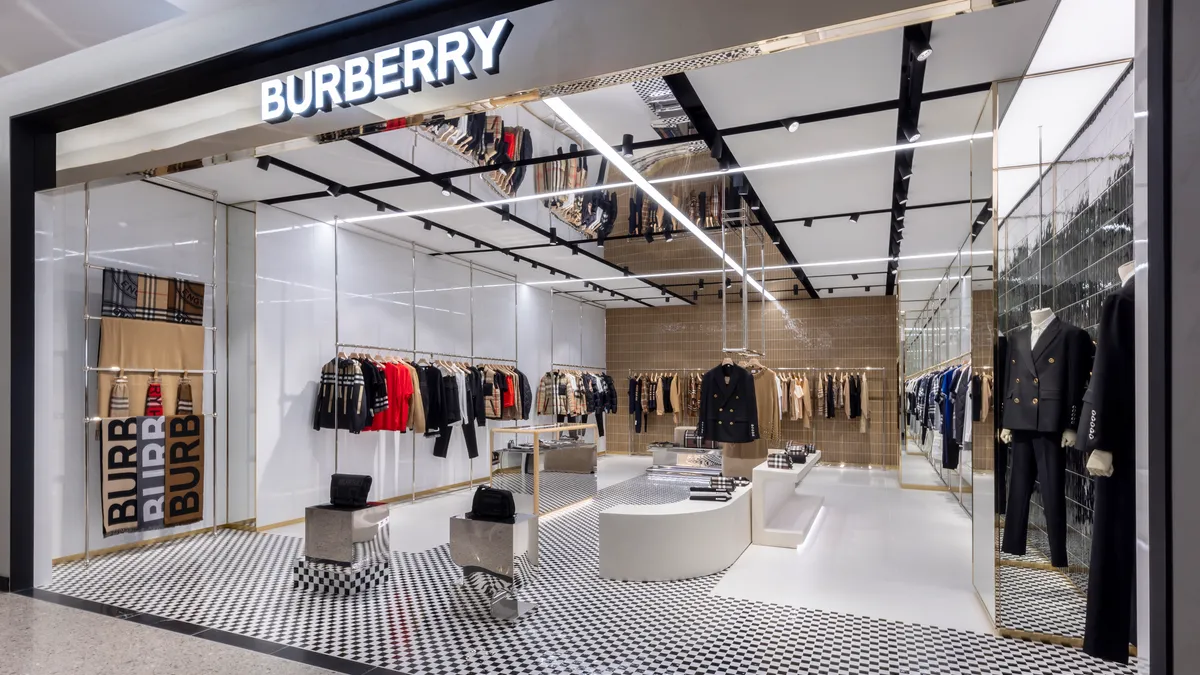The following is part of Retail Dive's "$500 million question" series, which asks executives of retail companies of all sizes and stripes how they would invest half a billion dollars in "found money" toward their operation.
Destination XL is a pretty good case study in how the pandemic landed on apparel retailers.
With the retailer specializing in part in men's occasionwear and workwear, months of widespread social hibernation — cancelled weddings and parties, closed offices, virtual conferences — weighed heavily on demand for its products. With sales down, its net losses increased more than eight times over in fiscal 2020. Last August, S&P Global Market Intelligence added the company to its list of retailers most vulnerable to default.
As with much of the apparel industry, Destination XL bounced back this year in dramatic fashion as more of the social world reopened and consumer demand swelled. For the first nine months of its fiscal year, Destination XL's sales have not only come roaring back from last year (up 70%) but are above 2019 levels as well.
Measures of financial health from RapidRatings in the fall showed Destination XL had the most significant improvement of any other retail company in the cohort studied by the analysis firm. And it's been months since the big-and-tall specialist appeared on S&P's ominous list of vulnerable companies.
The company is looking to do more than rebound from last year's travails. CEO Harvey Kanter said in Destination XL's third quarter earnings release that it was "well positioned to pursue an aggressive growth strategy."
As it looks to grow and take for itself more market share in the men's big-and-tall space, we asked leaders with the company the $500 million question: How would you invest half a billion dollars in free money — should it drop out of the sky and onto their books — to improve your business and operations?
Comments have been edited for length and clarity.
Harvey Kanter, CEO: We're asked that question with some degree of regularity on calls with investors right now. There's no question our first priority is we would invest in technology. And the way we prioritize those investments would be first and foremost marketing-oriented technology, customer-facing technology — things that we think would help us evolve even further in what we describe as a richer, more profound relationship with consumers.
And then the second element of technology would be things that are more infrastructural and continuing our progression in our digital transformation from what, I would say, is a legacy based brick-and-mortar retailer to a retailer that is more modern in its practice, and has opportunities to continue to evolve efficiency and productivity through the retirement of legacy based infrastructure, and the development of more modern infrastructure. At a high level that would be our priority.
There's really two ends of technology specifically oriented around the customer. One is what we call marketing and consumer engagement. That [includes] elements of personalization, whether that's evolving how we email consumers, embedding in emails certain things, understanding what data architecture and analytics does in terms of technology and allowing us to personalize elements. And gifting technology — there are so many platforms on gifting today, and gifting as an embedded part of our loyalty program.
The other element is content and community, whether it's TikTok or Instagram Live, or just literally static postings, but embedding deeper in what we would call platforms that consumers are highly engaged around.
Elements of that then lead themselves to elements of visualization and in-store engagement, even things like mirrors that actually allow the customer to see what products look like and without leaving the fitting room — to have really a catalogue of products that can be embedded up on a mirror that the customer can put on, once we've gone and sized the customer.
And then obviously, certain things like made-to-measure. We are using and testing and working our way through really looking at opportunities to use digital fitting — digital fitting today being really about what we sell in the store, and what sizes, relative to what brands would be most relevant. The extension of that — and I think it's still leading edge — but we are exploring using those fittings digitally to enhance our made-to-measure business and really produce product that is either entirely custom or partially custom.
Last but not least in terms of engagement would be customer care. We continue to have our own customer care practice. And really what we're talking about is the call center. Because we believe that the experience we're trying to create cannot really be farmed out. The understanding of the unique needs of an underserved customer in the segment that we exist is really important. And so, digital live chat as a for-instance: instead of just literally phone chat, digital live chat with a customer care agent in the corporate office.
Ujjwal Dhoot, Chief Marketing Officer: The reality is that the customer is changing, and the trends are changing, and their behaviors change so frequently that you have to keep up with it. So you have to invest in continuing to understand the customer. And then the second step from there is based on making sure you have all the right elements across all channels to be able to act on the customer. And our holy grail, which we pursue every day in our experience, is our one-to-one personalized experience that we offer our customers across all channels.
If I'm a customer who has bought Polo or Ralph Lauren 30 days ago, and we have new product coming in, we can email the customers, or that specific store manager can email, saying, 'Hey, by the way, do you know we have a new drop coming, and you can come in and check it out?' So that level of engagement, that the customer knows the store manager, is really what we're trying to drive.
Kanter: The other element is around technology as it relates to the distribution of goods and services for us. It's not a secret — we're a public company — we have one distribution center, it's literally 30 football fields big. In terms of speed to market, in terms of productivity and efficiency, if we had half a billion dollars of money, we would continue to challenge ourselves — and over time we will, but you know, half a billion dollars of found money would allow you to go faster in terms of speed to market, proximity payments, handhelds, real time inventory, stores, DCs.
Just look at RFID. We have RFID in our warehouse, we don't have RFID in all our stores, all our goods are not ticketed [with] RFID. It's common knowledge that we don't have 100% inventory accuracy in stores. We have pretty high-level inventory accuracy. But when you're doing fulfillment and every store is actually a mini-DC, and you do a pick, pack and ship using an algorithm from a store and it's not there, you have to go through a process. If every single garment was RFID, you would either know it is there or not there.
Dhoot: To be a true omnichannel retailer, and to have an equitable experience for the customer, no matter where they shop, we're focusing less on the channel and more on the customer.
As a consumer, you could browse on the app, then browse on the web, then go to a store, or you could browse in store and say, 'I want this but it's not in this store.' So we can ship it from another store to that store when when we have that capability. We can also, while you're in store, ship it to your home. You can order online and pick up in the store or curbside. So we're really thinking about all the permutations and combinations of how customers start their journey and end their journey, and making it frictionless.
The backbone of that is really the real-time inventory, because a customer could order an entire outfit — and our systems are meant to optimize so that it comes from the minimal amount of locations — but they could come from two stores and the DC, if that's where the inventory is. And we have to do that to serve the customer.
Kanter: One of the things we're pursuing, I think it's important, is data architecture and understanding one view of the customer. The other thing embedded in that is, we think about our business as a commerce business. So, we're generating commerce. We're not an e-tailer. We're not a brick-and-mortar retailer. The consumer has all the power. We have to provide them access to interact with us, but we're creating commerce and the consumer is deciding where they want to shop, when they want to shop. We're not a channel-driven business.
This story was first published in our weekly newsletter, Retail Dive: Operations. Sign up here.























